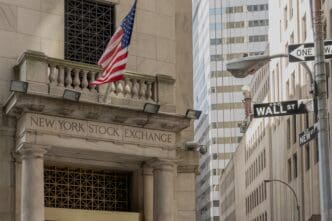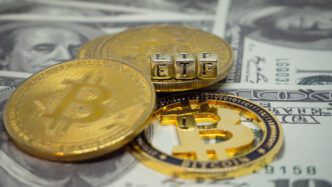New York, NY – Wall Street is bracing for a week of intense volatility as investors find themselves caught in a three-way tug-of-war between the alarming specter of geopolitical conflict, the monumental weight of a U.S. Federal Reserve interest rate decision, and the relentless, gravity-defying momentum of the artificial intelligence sector. After a week that saw early gains vaporized by a sudden military escalation in the Middle East, the market enters the week of June 16, 2025, on a decidedly anxious footing, with its future direction hinging on which of these powerful narratives will dominate investor sentiment.
The positive trajectory of the market was abruptly shattered last Friday following Israel’s overnight strikes on Iranian military and nuclear infrastructure. The reaction was swift and severe, snapping winning streaks for the S&P 500 and Nasdaq and serving as a stark reminder of how quickly geopolitical shocks can override economic data. Now, as traders return to their desks, the central question is whether the market can shake off the pall of global uncertainty or if fear will dictate the week’s trajectory.
The Geopolitical Shadow Looms Large
The week will undoubtedly open under the long shadow of Friday’s dramatic market reaction. The 1.13% drop in the S&P 500 and the 1.3% fall in the Nasdaq Composite were directly fueled by fears of a wider, more unpredictable conflict. The immediate flight to safety was evident as gold prices surged to a two-month high, while the surge in crude oil futures—with Brent up roughly 7% and WTI up 7.5%—sent a ripple of fear through global supply chains as traders priced in a significant risk premium.
This geopolitical “wild card” will remain the most unpredictable variable throughout the week. Any news of further escalation or retaliation from Iran could trigger another sharp leg down in equities and a corresponding spike in energy and defense stocks. Conversely, signs of de-escalation or successful diplomatic intervention could allow the market to breathe a sigh of relief and refocus on economic fundamentals. While a preliminary U.S.-China trade framework focused on rare-earth minerals offered a small dose of stability last week, the six-month limit on China’s export license leaves its long-term impact highly uncertain, doing little to offset the more immediate Middle Eastern threat.
All Eyes on the Federal Reserve
While geopolitics provides the unpredictable backdrop, the week’s main scheduled event is unquestionably the Federal Reserve’s Federal Open Market Committee (FOMC) meeting, concluding on Wednesday. Despite encouraging inflation data last week—with both the Consumer Price Index (CPI) and Producer Price Index (PPI) for May coming in cooler than anticipated—the consensus is overwhelming that the Fed will hold its benchmark interest rate steady.
Fed policymakers remain cautious, balancing the recent disinflationary trend against inflation that is still running above their 2% target and the unknown price impact of the Trump administration’s recent tariffs. Therefore, the rate decision itself is a foregone conclusion. The real market-moving action will come from the accompanying policy statement and Fed Chair Jerome Powell’s subsequent press conference.
Investors will be dissecting every word for clues about the future path of monetary policy. The primary focus will be on the updated “dot plot,” which reveals individual members’ projections for interest rates. The market is currently pricing in rate cuts for the second half of 2025, and any significant shift in the dot plot—either suggesting fewer cuts or a later start—could rattle both equity and bond markets. Powell’s tone on the economy’s resilience and his assessment of geopolitical risks will be critical in shaping the market’s outlook. Adding to the global monetary policy focus, the Bank of England, Bank of Japan, and Swiss National Bank are also holding meetings, ensuring a week of heightened potential volatility in currency markets.
Wall Street Braces for Volatile Week
Themes to Watch This Week
Geopolitical Risk: HIGH
Economic Focus: Central Banks
Sector Spotlight: AI & Defense
Market Snapshot: A Winning Streak Snapped
Weekly Performance Ending June 13, 2025
Key Economic Events This Week
The Unstoppable AI Engine
Providing a powerful and optimistic counter-narrative to the macroeconomic and geopolitical gloom is the generative artificial intelligence sector. This technology gold rush continues to be the market’s primary engine of growth and a source of seemingly boundless investor enthusiasm.
Last week served as a perfect microcosm of this dynamic. While Apple’s developer conference failed to deliver the major AI announcements investors had hoped for, the rest of the sector more than picked up the slack. Meta Platforms energized the market with its substantial investment in Scale AI, Oracle’s stock surged after it projected a tripling of its AI computing revenue, and AMD unveiled its new AI server chip, a direct challenger to Nvidia’s market dominance. Speaking in Paris, Nvidia CEO Jensen Huang reiterated the insatiable demand for compute capacity, forecasting a tenfold increase in Europe alone over the next two years.
This robust, long-term growth story continues to attract significant capital, providing a fundamental pillar of support for the tech-heavy Nasdaq and the broader market. For many investors, the transformative potential of AI is a compelling reason to stay invested, even as external risks mount.
A Week of Precarious Balance
Ultimately, the week ahead is shaping up to be a battle for control of the market narrative. Will the fear stoked by missiles in the Middle East dominate, pushing investors towards safe havens? Or will the hope offered by cooling inflation, a potentially dovish Fed pivot, and the explosive growth in AI win out? Key economic data, including U.S. Retail Sales on Tuesday and Housing Starts on Thursday, will provide further insight into the health of the consumer and the economy. With trading volumes expected to be lighter on Thursday due to the Juneteenth holiday, any significant market moves could be amplified. The outcome is far from certain, but one thing is clear: investors should buckle up for a volatile ride.







